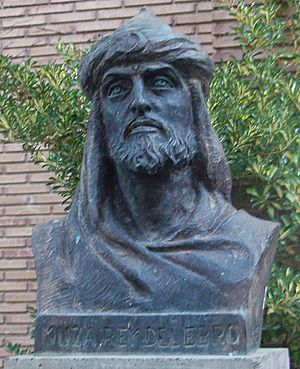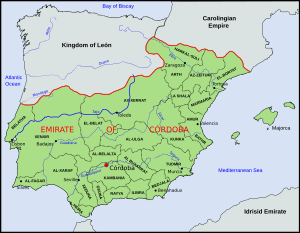Viking raid on Seville facts for kids
Quick facts for kids Viking raid on Išbīliya |
|||||||
|---|---|---|---|---|---|---|---|
| Part of Viking expansion | |||||||
|
|||||||
| Belligerents | |||||||
| Vikings of Noirmoutier, Francia | |||||||
| Commanders and leaders | |||||||
| Unknown | Isa ibn Shuhayd Musa ibn Musa al-Qasi Abd al-Wāḥid ben Yazīd al-Iskandarānī |
||||||
| Strength | |||||||
| Early Muslim accounts: 16,000 men 80 ships |
unknown | ||||||
| Casualties and losses | |||||||
| Early Muslim accounts: 500–1000 killed 30 ships destroyed |
Unknown | ||||||
The Viking raid on Išbīliya happened in 844. At that time, Išbīliya was part of the Emirate of Córdoba, a Muslim kingdom in what is now Spain.
A large Viking fleet sailed along the coasts of Spain and Portugal. On September 25, they reached Išbīliya, which is known today as Seville. They sailed up the Guadalquivir River to get there. The Vikings took control of the city on October 1 or 3. They robbed and destroyed parts of the city and the areas around it.
The leader of Córdoba, Emir Abd ar-Rahman II, quickly gathered a strong army. He sent his chief-minister, Isa ibn Shuhayd, to lead the fight against the Vikings. After several battles, the Muslim army defeated the Vikings on November 11 or 17. Seville was taken back, and the remaining Vikings left Spain.
After this attack, the Muslims built more ships and improved their defenses. They wanted to protect their coast from future raids. This quick response and better defenses helped stop other Viking attacks later on. Historians say that the Muslim response was much stronger than how other European kingdoms dealt with Vikings at that time.
Contents
How the Raid Started

The Umayyad Caliphate was a large Muslim empire. After a big change called the Abbasid Revolution, Muslims in Spain created their own independent kingdom. This was the Emirate of Córdoba, founded in 756. Its capital city was Córdoba. Many people who fled the revolution came to Spain. The emirate quickly became a place of great learning and new ideas.
The 844 raid was the first major Viking attack known in Spain. Before this, there might have been smaller Viking visits to the Kingdom of Asturias. This was a Christian kingdom to the north of the Muslim lands. At the time, the Muslim emirate and the Christian kingdoms in Spain often had small fights. There was a kind of neutral zone between them.
The Vikings' Journey
Before reaching Seville, the Viking fleet was seen near the coast of France. They sailed on French rivers like the Seine and the Loire. They attacked Asturias, which was ruled by King Ramiro I. But the Vikings lost many men there and were defeated by Ramiro.
Next, they sailed south along the Atlantic coast. They captured the Muslim city of Lisbon in August or September of 844. They stayed there for 13 days and fought with the Muslims. The governor of Lisbon sent a message to Emir Abd ar-Rahman II in Córdoba. He was the main leader of the Muslims in Spain.
After leaving Lisbon, the Vikings continued south. They raided other Spanish towns like Cadiz and Medina Sidonia. They also attacked Algeciras and possibly Asilah in modern-day Morocco.
The Attack on Seville
On September 25, the Vikings arrived near Seville. They sailed up the Guadalquivir River. They set up their main camp on Isla Menor. This was an island in the river marshes that was easy to defend. On September 29, local Muslim forces tried to fight the Vikings but were defeated.
The Vikings then attacked Seville on October 1 or 3. They broke through the city's defenses after a short fight. They robbed and destroyed the city. Muslim historians wrote that the Vikings brought "terrors of imprisonment or death" to the people. They even harmed animals.
Although the city of Seville was captured, its strong fortress remained in Muslim hands. The Vikings tried to burn the city's main mosque, which had been built recently, but they failed.

When Emir Abd ar-Rahman II heard that Seville had fallen, he quickly gathered his army. His chief-minister, Isa ibn Shuhayd, led the forces. The Emir also asked other governors to bring their soldiers. They all met in Córdoba and then marched to Axarafe, a hill near Seville. Isa ibn Shuhayd set up his command center there.
A group of soldiers led by Musa ibn Musa al-Qasi also joined the army. Musa ibn Musa was the leader of a semi-independent region to the north. Even though he had some disagreements with Abd ar-Rahman, he played a very important role in fighting the Vikings.
Over the next few days, the two sides fought many times. The results were mixed. But finally, the Muslims won a big victory on November 11 or 17 at a place called Talyata. Muslim records say that between 500 and 1000 Vikings were killed. Also, 30 Viking ships were destroyed. The Muslims used a special burning liquid called Greek Fire to set the enemy ships on fire.
The Muslims also reported that the Viking commanders were killed. At least 400 Vikings were captured. Many of them were hanged from the palm trees in Talyata. The remaining Vikings went back to their ships and sailed down the river. People from the countryside threw stones at them as they left.
Soon, the Vikings offered to trade the things they had stolen and the prisoners they had taken. In return, they wanted clothes, food, and a safe trip down the river. After this, they joined the rest of their fleet on the coast. The weakened Viking fleet then left Spain. They made a quick raid in the Algarve region before sailing away. Abd ar-Rahman's ships followed them.
What Happened Next
The city of Seville and its surrounding areas were badly damaged. The Viking attack scared the people of Al-Andalus. Abd ar-Rahman ordered new plans to protect against future raids.
He built a naval base in Seville. He also built strong walls around the city and other towns. New ships and weapons were made. More sailors and soldiers were trained. A network of messengers was set up to quickly share news about any future attacks. These new defenses worked well. They helped stop later Viking raids in 859 and 966.
Most of the Vikings sailed back to Francia (modern-day France). Their big defeat by the Muslim army might have made them think twice about attacking Spain again. The next year, the Vikings sent a group to meet Abd ar-Rahman. The Emir then sent a poet named Yahya ibn al-Hakam to be his ambassador to the Vikings. Later Muslim stories say that some of the Vikings stayed in the area. They became Muslims and worked as cheese traders.
|
See also
 In Spanish: Ataque vikingo a Sevilla para niños
In Spanish: Ataque vikingo a Sevilla para niños


